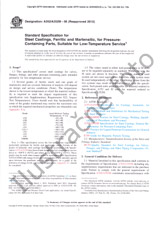Potrebujeme váš súhlas na využitie jednotlivých dát, aby sa vám okrem iného mohli ukazovať informácie týkajúce sa vašich záujmov. Súhlas udelíte kliknutím na tlačidlo „OK“.
ASTM E2637-17
Standard Guide for Utilizing the Environmental Cost Element Structure Presented by Classification
NORMA vydaná dňa 1.3.2017
Informácie o norme:
Označenie normy: ASTM E2637-17
Poznámka: NEPLATNÁ
Dátum vydania normy: 1.3.2017
Kód tovaru: NS-683169
Počet strán: 10
Približná hmotnosť: 30 g (0.07 libier)
Krajina: Americká technická norma
Kategória: Technické normy ASTM
Kategórie - podobné normy:
Anotácia textu normy ASTM E2637-17 :
Keywords:
CERCLA, characterization, cleanup technology, code of accounts, cost elements, cost estimation, cost management, decommissioning, decontamination, ECES, environmental cost element structure, environmental management, environmental remediation, environmental restoration, life-cycle costs, life-cycle phases, operation and maintenance, phases, program management, project management, RCRA, remediation, site investigation, standard classification, surveillance and long-term monitoring
Doplňujúce informácie
| Significance and Use | ||||||||||
|
5.1 In addition to its cost management and project management functions, the ECES can also be used to support a number of other program and project functions. These functions include: 5.1.1 Bid solicitation, collection, and evaluation; 5.1.2 Communicating project data between installations, complexes, agencies, and industry; 5.1.3 Providing a project checklist; 5.1.4 Cost and schedule estimating; 5.1.5 Historical cost/schedule data collection; 5.1.6 Historical project data collection (for example, technology deployments, project conditions); 5.1.7 Validating and calibrating cost estimates and software tools; and 5.1.8 Establishing and disseminating best practices and lessons learned. 5.2 Several government agencies are already incorporating this structure into existing and future cost estimating models, databases, and other similar software tools and systems. |
||||||||||
| 1. Scope | ||||||||||
|
1.1 The Environmental Cost Element Structure (ECES) covered by Classification E2150 (and Adjunct E2150) provides a consistent and comprehensive structure across all phases of environmental remediation projects and is a tool to improve the cost management of those projects. This guide is intended to facilitate the application of the ECES to any environmental remediation project, without regard to project size. 1.2 Classification E2150 establishes the broad, top-level framework for environmental remediation projects by providing a hierarchical list of project elements to two levels of detail. Its associated Adjunct E2150 supports the top-level structure by providing more detailed elements and definitions of the ECES to three additional levels of detail. Although it is assumed that the user is familiar with Classification E2150, much of the content of the classification is repeated in this guide to relieve the user of the burden of back-and-forth referencing during use. It is assumed, however, that all users of this guide will have at hand both Classification E2150 and the Adjunct E2150 during project planning. 1.3 The values stated in SI units are to be regarded as standard. No other units of measurement are included in this standard. 1.4 This standard does not purport to address all of the safety concerns, if any, associated with its use. It is the responsibility of the user of this standard to establish appropriate safety and health practices and determine the applicability of regulatory limitations prior to use. 1.5 This international standard was developed in accordance with internationally recognized principles on standardization established in the Decision on Principles for the Development of International Standards, Guides and Recommendations issued by the World Trade Organization Technical Barriers to Trade (TBT) Committee. |
||||||||||
| 2. Referenced Documents | ||||||||||
|




 Cookies
Cookies
